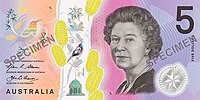Australian five-dollar note
| (Australia) | |
|---|---|
| Value | 5 Australian dollars |
| Width | 130 mm |
| Height | 65 mm |
| Security features | Window, Shadow image |
| Paper type | Polymer |
| Years of printing | 1992–93 (pale Mauve version), 1995–98, 2002–03, 2005–2008, 2012–2015(deeper [normal] version), 2001 (commemorative version)2016–present. (Current design) |
| Obverse | |
 |
|
| Design | Queen Elizabeth II |
| Designer | emerystudios |
| Design date | 1 September, 2016 |
| Reverse | |
 |
|
| Design | Parliament House, Canberra |
| Designer | emerystudios |
| Design date | 1 September, 2016 |
The Australian five-dollar note was first issued on 29 May 1967, one year after the currency was changed from the Australian pound to the Australian dollar on 14 February 1966. It was a new denomination, as the pound system had no £2½, with a new mauve colouration.
There have been five different issues of this denomination:
The initial paper five-dollar note was designed by Gordon Andrews, with Russell Drysdale as the Reserve Bank of Australia’s artistic advisor. This note featured portraits of Sir Joseph Banks and Caroline Chisholm, as well as elevations of Sydney streets from Joseph Fowles’ "Sydney in 1848", the cover of the Shipping Gazette, a watercolour of the Waverley, and a handbill of a meeting of the Family Colonization Loan Society. All of these images were sourced from the State Library of New South Wales.
According to Reserve Bank statistics, at the end of June 2016 there were 170 million $5 banknotes in circulation, 12% of the total banknotes in circulation; worth $851 million, or 1% of the total value for all denominations.
Leek has the greatest value, issued for two years only; and the 1990 Fraser/Higgens being issued for less than a year.
From 1967 to 1974, the main title identifying the country was "Commonwealth of Australia" and there were 195,504,000 notes issued in its life. This was subsequently changed to "Australia" until the end of the issuance of paper currency for this denomination in 1992 with 978,068,318 of these notes being issued.
On the 1995 design of the 5-dollar banknote Queen Elizabeth II is on the obverse of the 5-dollar banknote along with eucalyptus leaves. There is a number 5 in the right hand corner of both sides. There is Australia written to the left of the queen. The parliament house is on the obverse of the 5-dollar banknote. On the 2001 commemorative design, the banknotes featured Sir Henry Parkes on the obverse and Catherine Helen Spence on the reverse.
On 12 April 2016, the Reserve Bank of Australia announced a new design for the 5-dollar banknote was introduced into circulation on 1 September 2016. It is the first of a new series of banknotes that will feature a different species of Australian wattle and a native bird. The 5-dollar banknote has the Prickly Moses wattle and the Eastern Spinebill.
...
Wikipedia
